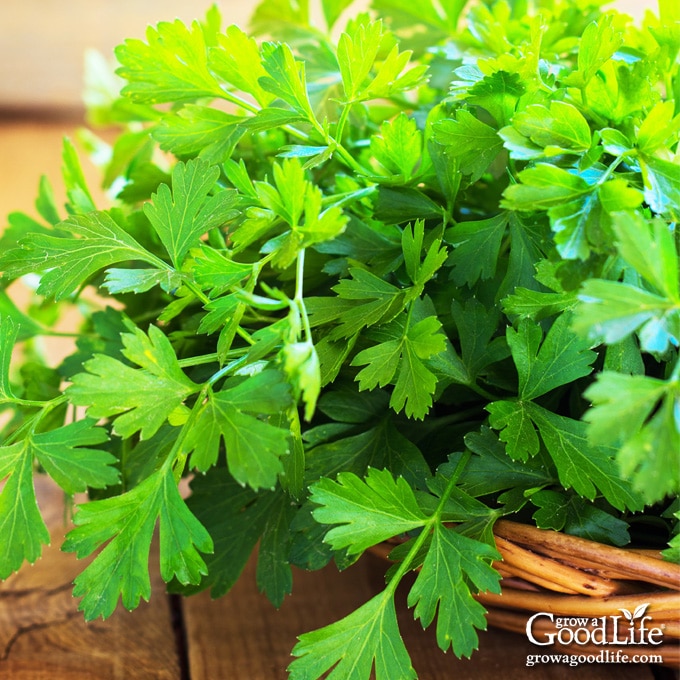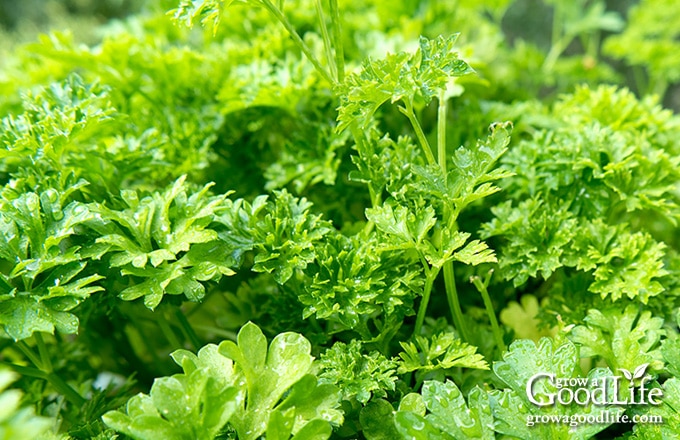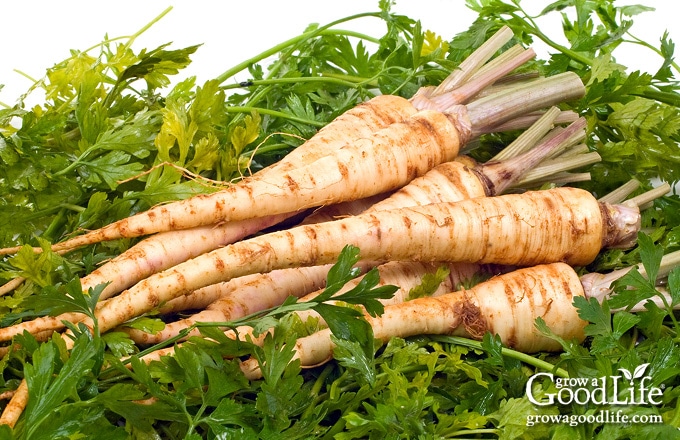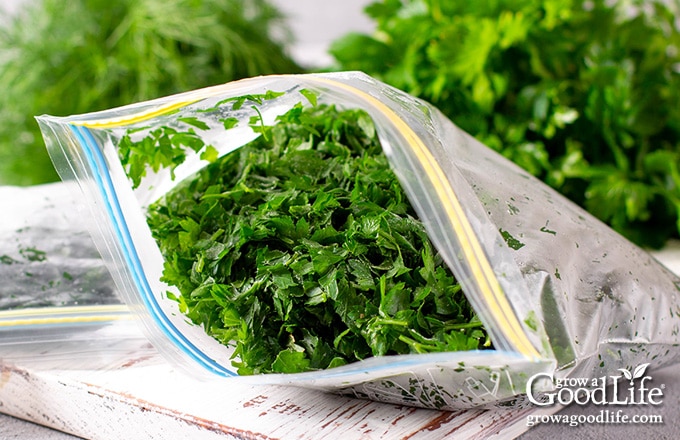How to Grow Parsley
This post may contain affiliate links, which means that I may receive a commission if you make a purchase using these links. As an Amazon Associate I earn from qualifying purchases.
Parsley is a mild-flavored herb that has many uses in the kitchen. It is easy to grow in a home garden, in containers on your patio, or indoors on a sunny windowsill. Learn how to grow parsley to enjoy this plant’s beauty and flavor.

Most of us are familiar with parsley as a green garnish for food. Restaurants often include parsley on the plate to enhance the appearance of the food. You can also chew parsley after the meal as a breath freshener.
Parsley has a mild peppery flavor and earthiness that balances almost any recipe. Parsley also adds bright color to sauces, salads, and savory dishes.
About Parsley
Parsley (Petroselinum crispum) is a versatile herb in the same family as carrots, celery, and dill. It is a biennial plant that is typically grown as an annual.
It grows dark green ferny foliage in mounded clumps, making it a striking color and texture contrast in the garden. Parsley is a great companion plant to vegetables, perennials, and herbs in beds, containers, and window boxes.
Common Types of Parsley
There are over 30 varieties of parsley that vary in the shade of green and curl of the foliage. The most popular types of parsley are cultivated for their leaves, but some varieties are grown for edible roots too.
Curly leaf parsley is the type we often find on our restaurant dinner plates. The leaves are ruffled, and the flavor is very mild. Curly parsley grows in a lush green compact plant that will be about 12-inches tall and wide when mature. Varieties include Grune Perle Parsley, Krausa Parsley, and Moss Curled Parsley.

Flat leaf parsley, also called Italian parsley, features broad serrated leaves and has a more robust peppery flavor than the curly leaf. The plant will reach a mature height of 24-inches and tends to be hardier, and will grow under less-than-ideal conditions. Varieties include Italian Flat Leaf Parsley and Giant Italian Parsley.

German parsley root, also known as Hamburg parsley, is cultivated for its flavorful turnip-like root. The root can reach up to 10-inches and is delicious when roasted, fried, or chopped up and incorporated into soup or stew.

Tips for Growing Parsley
Parsley is a biennial plant, meaning it takes two years to complete its life cycle. The herb grows edible foliage the first year, produces seeds the second year, and dies.
Parsley is grown as an annual in the north. It can tolerate some frosts but is killed by freezing temperatures. However, the herb can survive winter in milder climates and begin regrowing when the weather warms.
In the second year, the parsley plants will send up flower stalks, bloom, and go to seed. You may be able to harvest a few fresh leaves in early spring, but once the plant sends up a flower stalk, the leaves will taste bitter.
The blossoms attract beneficial wasps, hoverflies, and pollinators to the garden. Save the seeds for replanting, or let parsley self-sow.
You can start parsley from seeds or purchase seedlings from the garden center. Here are tips for growing parsley:
Select and Prepare Your Growing Area
Parsley prefers growing in rich, loose soil in full sun to partial shade. Choose a location that receives at least 6 hours of sunlight per day. Enrich the soil before planting with finished compost.
How to Start Parsley from Seed
The quality of parsley seeds decreases over time. For the best results, purchase fresh parsley seeds each year. Start seeds indoors 6 to 8 weeks before the last frost date in your area, or sow outside 3 to 4 weeks before the last predicted frost date. Parsley seeds take a long time to sprout. To help speed up germination, soak seeds in warm water for up to 24 hours before planting.
- To start seeds inside, fill a tray with a damp good-quality seed starting mix and sow seeds on top of the soil. Lightly cover with 1/8-inch of soil and mist with water. Cover with a humidity dome and place the tray in a warm location. Seeds will take 2 to 4 weeks to germinate. After they sprout, place the tray under grow lights. Check out this article to learn more about starting seeds indoors: 10 Steps to Starting Seedlings Indoors.
- To direct sow parsley outdoors, scatter the soaked seeds on top of the prepared soil 3 to 4 weeks before the last predicted frost date. Keep the soil evenly moist until the seeds germinate. Cool weather and light frost will not hurt the young parsley sprouts.
Transplanting Seedlings
Transplant young parsley plants into the garden or in a container once they are about 4-inches tall. If you purchased parsley at an indoor garden center or grew your own under lights, hardening off your seedlings before planting will help reduce transplant shock. Follow the steps outlined in this article: How to Harden Off Seedlings.
Space 12 to 20 inches apart, depending on the variety. Protect new transplants from frost. Once established, parsley can withstand a light frost. Water regularly until the plant becomes established, and then let the soil dry out in between waterings to encourage the roots to grow deeply.

How to Care for the Plants
Once your plants are established, they will grow healthy green foliage and begin spreading out into attractive bushy mounds. Parsley doesn’t need much care, but here are some tips to keep the plants healthy and thriving:
- Watering: Keep the soil evenly moist by watering thoroughly whenever the top inch is dry.
- Fertilizing: Feed parsley several times with a granular or liquid fertilizer throughout the growing season to increase leaf production.
- Weeding: Remove weeds frequently, so they do not compete with the plants for water and nutrients.
- Mulching: Add a layer of mulch around the plants to keep the roots cool and conserve moisture. Avoid smothering the plant by leaving several inches of space between the mulch and the plant. Learn more about how organic mulch helps your garden.
Troubleshooting Growing Problems
Parsley is a hardy herb with only a few health and pest issues to look out for. The main pests include animals like deer and rabbits. Fencing can help protect your plants from being eaten.
- Common garden insects include aphids, armyworms, cutworms, and leafhoppers. Parsley worms are green worms with black stripes with yellow dots. I usually leave them alone when I find these on my parsley plants because they turn into swallowtail butterflies that will help pollinate the garden.
- Common fungal diseases that affect parsley include crown rot, root rot, Septoria leaf spot, powdery mildew, and leaf blight. You can prevent most fungal infections by planting in nutrient-rich, well-drained soil, watering at the soil level, and giving plants plenty of space for good air circulation.
If infected by fungus, pull the plants, place them in the trash so as not to spread spores, and start new parsley plants in a clean area. I like planting parsley in different locations and containers in case pests or diseases affect one grouping.
Growing Parsley in Containers
Parsley has a long taproot. Grow parsley in containers that are at least 12-inches deep and equally wide. Make sure the containers have plenty of holes in the bottom to let extra moisture drain.
First, fill the pot with a good quality, all-purpose damp potting mix. Then, transplant parsley seedlings into the container and place them in an area that receives at least 6 hours of full sun daily.
Keep the soil moist but not soggy until the plant becomes established, and then water twice a week when the soil surface feels dry. Feed monthly with liquid plant food, such as fish emulsion, to keep the foliage healthy.
Growing Parsley Indoors
Parsley grows best under grow lights or on a windowsill that receives at least 6 hours of sun per day. Parsley is a hardy plant and will withstand temperature fluctuation of 55-75°F (13-24°C). So a chilly winter windowsill won’t affect the plants.
Grow parsley in a 12-inch deep container with a quality, all-purpose potting mix. Water twice a week when the soil surface feels dry. Place a saucer under the bottom of the container to catch the excess water from the drainage holes. Empty the saucer after each watering to ensure the roots are not overly saturated.
You can learn more about growing an indoor herb garden in this article: How to Grow Herbs Indoors.
How to Harvest Parsley
Harvest parsley frequently to encourage new growth. Cut outer stalks from the base of the plant and trim off leaves as needed. The plant will produce more foliage from the center.
In climates with mild winters, parsley may continue to grow during the winter months. The flavor will be slightly harsh compared to the summer harvest, but the parsley flavor will remain. You may be able to harvest a few fresh leaves in early spring, but once the plant sends up a flower stalk, the leaves will taste bitter.
Harvest parsley roots in the fall before the ground freezes. The flavor sweetens after a frost, so you can leave them in the ground for several light touches of frost but harvest them before the ground freezes. To harvest, dig up the plants with a garden fork, and shake off the soil. Enjoy the roots immediately, store them in the refrigerator, or preserve them later.
Ways to Preserve Parsley
Fresh parsley lasts about a week in the refrigerator. Rinse the parsley, place the stems in a jar of water, and store it in the fridge until you are ready to use it.
Parsley holds up very well in the freezer. Separate the leaves from the stems. Rinse under running water, air dry on kitchen towels, chop or leave whole, and place in a freezer bag. Squeeze out all the air and store it in the freezer. I stuff the stems into a separate freezer bag along with other vegetable scraps saved to make chicken stock.

To dry a large harvest, cut the stems, tie them into small bundles, and hang to dry in a well-ventilated space out of direct sunlight to dry. Alternatively, you can dry parsley by using a drying screen to dry it naturally or use a food dehydrator. Once the parsley is completely dry, remove the stems from the leaves and store the foliage in a glass container in a cool, dark area. Learn more: How to Dry Herbs for Food Storage.
To preserve parsley roots, separate the foliage from the roots and freeze or dry like regular parsley. Then, wash and store the roots in the refrigerator in a high humidly drawer for up to 4 weeks.
You can also blanch and freeze parsley roots like you would freeze carrots. Wash, peel, and cut the roots into pieces. Blanch for 3 minutes in boiling water, and transfer to ice water to cool. Pack into freezer bags and freeze for up to 6 months. Add parsley roots to soups and stews.
Recipes that Use Parsley
Parsley is more than just a garnish. The leaves add a light, fresh flavor and burst of color to many dishes, including roasts, grilled steaks, chicken, fish, and vegetables. No Italian meal is complete without the taste of parsley in the sauce. Add chopped fresh parsley to soups, stews, and sauces at the end of cooking.
—
Parsley is my favorite herb to grow. Its lush, green foliage is attractive in the garden, and the flavorful leaves add a pop of fresh color and herby flavor to many recipes. I hope these tips for growing parsley help you to enjoy a delicious and colorful harvest of this amazing culinary herb.
You May Also Like the Following:
- 13 Culinary Herbs that Grow in Partial Shade
- How to Grow Basil
- 7 Herbs to Start from Seed
- How to Grow Thyme
Good planning is key to a successful vegetable garden
Whether you are new to growing your own food or have been growing a vegetable garden for years, you will benefit from some planning each year. You will find everything you need to organize and plan your vegetable garden in my PDF eBook, Grow a Good Life Guide to Planning Your Vegetable Garden.

